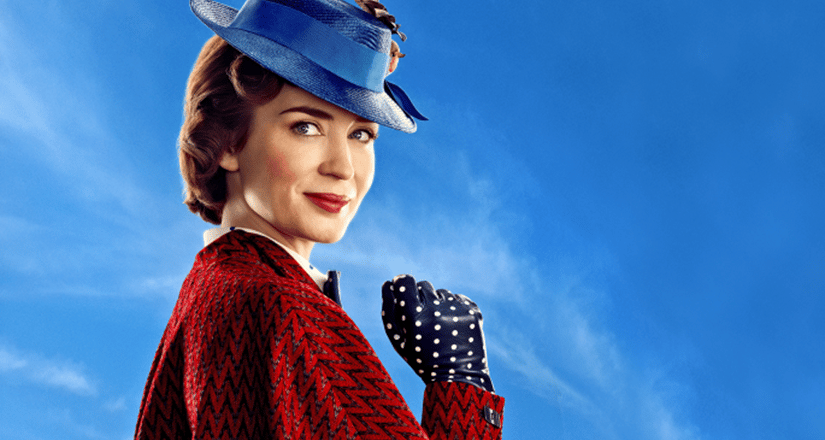Read also:
How to Watch FX Live Without CableHow To Watch AMC Without CableHow to Watch ABC Without CableHow to Watch Paramount Network Without CableRob Marshall’s handsomely-rendered revival of the classic Disney character is filled with charming spectacle and a great Emily Blunt performance, even as it sticks to playing the hits.
This piece was originally posted on Alcohollywood
Given Disney’s recent streak of just remaking all their old properties (to mixed results – the only great one so far has been David Lowery’s beautiful Pete’s Dragon), it’s actually a bit surprising that Mary Poppins Returns is a straight-up sequel. Or maybe it’s not, since Rob Marshall’s follow-up to the 1964 Julie Andrews classic plays like The Force Awakens to the original’s Star Wars – a structural replay of the characters and plot beats from its predecessor. When it’s this charming and beautiful to look at, though, it’s hard to complain – Mary Poppins Returns offers up a grand old time underneath the lovely London sky.
Taking place a couple of decades after the original, Returns follows the Banks children, all grown up – Michael (Ben Whishaw) is a widowed artist-turned-banker who still lives in the Banks house, raising his children Annabel (Pixie Davies), John (Nathanael Saleh) and Georgie (Joel Dawson) with the help of his childhood housekeeper Ellen (Julie Walters). Meanwhile, Jane (Emily Mortimer) has grown up in the mold of her suffragette mother, now fighting for labor rights while trying to help her brother keep the house afloat.
However, after some missed loan payments, the Banks house is set for foreclosure by Fidelity Fiduciary Bank (now run by Colin Firth’s two-faced manager) unless the Banks family can find old George Banks’ lost shares in the bank to sell and pay it off. Luckily, help arrives in the form of impish magical nanny Mary Poppins (Emily Blunt), who descends from the heavens to care for the Banks children and help them look for the shares – with the help of a handsome lightkeeper (Lin-Manuel Miranda) with the voice of an angel.
While director Rob Marshall’s track record is nothing if not spotty (Pirates of the Caribbean: On Stranger Tides, anyone?), his agreeable accessibility and command of musical sequences (he did direct Chicago, after all) makes him practically perfect to helm a fun, flighty kid’s film of this magnitude. The film’s many song-and-dance setpieces are wonderfully little showcases for Broadway legend Marc Shaiman’s delightful songs. Sure, many of them feel like stand-ins for cuts from the original – there’s a “Supercalifragilisticexpialidocious” number, a “Spoonful of Sugar” number, and so on – but they’re incredibly charming and delightful to watch nonetheless. The songs, like the film itself, feel like variations on what we’ve seen before, but they still manage to entertain on their own.
A lot of this is to do with the main cast, especially Blunt and Miranda, who are simply magical on screen. When Blunt reappears in the classic blue coat and tipped-up heels, it takes a few minutes to get used to her – but Blunt’s cheeky twinkle and beaming screen presence go a long way toward emulating that inimitable magic Julie Andrews brought to the role. As for Miranda, his lamplighter Jack feels perfunctory from a story perspective – he’s a lamplighter who just so happens to have grown up with Bert and Mary Poppins, so he slots in easily as the soot-covered Dick Van Dyke analogue. But his goofy not-quite-Cockney accent (almost certainly tuned up to match Van Dyke’s own dodgy efforts) and Miranda’s unquestionable song and dance skills make him invaluable in the musical sequences.
And what fun those sequences are, updating the original’s sense of animated imagination in new and delightful ways. “Can You Imagine That?” turns bathtime with Mary and the kids into a lush, colorful journey through a whimsical ocean, followed by the one-two punch of Mary and Jack escorting the kids into the animated world of one of their late mother’s China bowls, including the “Royal Doulton Music Hall.” There Marshall, gets to indulge in a Chicago-esque stage sequence featuring Blunt and Miranda singing a neat little ditty about how “a cover is not the book” – a nifty metaphor for Returns’ own desire to stand out from the original while slotting neatly into the first film’s aesthetic.
Of course, a spoonful of sugar makes the medicine go down, and Mary Poppins Returns manages to work in some slyly positive messaging amongst all the eye-popping colors. From song to song, Mary teaches the Banks kids (and those in the audience) the importance of seeing things from different perspectives, of finding ways to remember loved ones after they’re gone and to not judge people and things at first glance. Sure, they’re simplistic messages, but valuable ones, and hey – this is a kid’s movie.
One of Returns’ most unexpected charms is that, for a film made in 2018, it feels patently designed to emulate the sensibilities of classic studio filmmaking. Apart from the updated effects and the deliberate (but very welcome) efforts by Disney to diversify the main and background cast, Mary Poppins Returns could have dropped in theaters five years after the original with nary a feather ruffled. There’s an old-fashioned sensibility to the whole thing, an air of effortless possibility that feels positively quaint in a world where even kid’s films have to deal with the relentless cynicism of the modern day. Mary Poppins Returns doesn’t offer a complex, postmodern spin on what came before; it plays the hits, and it plays them well. Sometimes, that’s all we can ask for.
(P.S. In a film soaked in impossible happenings, let’s just say Van Dyke’s brief cameo performance is maybe the greatest piece of Disney magic you’ll see in quite some time.)
Mary Poppins Returns floats down from a cloud and into theaters Wednesday, December 19th.

